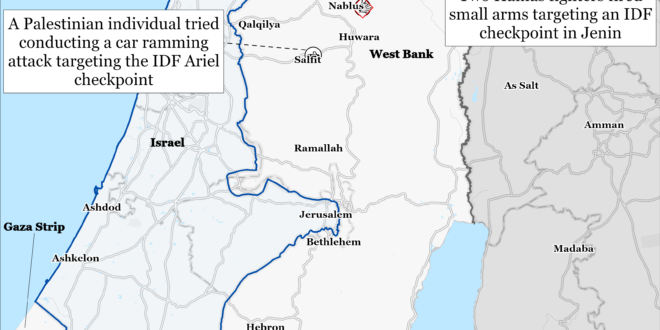Lebanese Hezbollah conducted a drone and rocket attack on Israel on August 24 in response to Israel killing a senior Hezbollah commander, Fuad Shukr. Hezbollah fired 200-300 projectiles, including around 20 one-way attack drones, in two waves into Israel.[1] Hezbollah fired rockets at 11 Israel Defense Forces (IDF) sites in northern Israel in the first wave of its attack.[2] These sites included a prominent IDF air defense and communications site on Mount Meron, which Hezbollah has targeted repeatedly since October 2023.[3] Hezbollah Secretary General Hassan Nasrallah said that the rockets were meant to distract Israeli air defenses and enable the second wave to penetrate deeper into Israel.[4] The second wave involved firing one-way attack drones targeting Ein Shemer base in Hadera and Glilot Base north of Tel Aviv.[5] This tactic of using imprecise and indirect fire to distract air defenses and then using precision weapons to strike targets has become common across Iran and its Axis of Resistance in recent years. Ein Shemer base hosts major IDF air defense assets, while Glilot base has signals intelligence functions.[6] The IDF stated that it intercepted some of the Hezbollah rocket fire in northern Israel and that Hezbollah failed to strike the bases in central Israel.[7] The IDF also reported that an IDF Navy member was killed in the Hezbollah attack.[8]
Hezbollah meant for its attack to be much larger than it was. The IDF conducted a series of preemptive strikes in southern Lebanon about 30 minutes before the attack was expected to begin.[9] The IDF Air Force struck around 40 locations and destroyed ”thousands” of Hezbollah rocket launchers and around 40 unspecified launch pads.[10] An Israeli military correspondent noted that the IDF Air Force destroyed over 200 targets ”within minutes.”[11] Israeli Defense Minister Yoav Gallant stated that the IDF destroyed between 50 and 67 percent of the munitions that Hezbollah planned to use in the attack.[12] Israeli officials later said that only some of the rocket launchers that Hezbollah positioned appeared to be meant for use in the attack. Hezbollah may have positioned more rocket launchers than it planned to use in order to obfuscate the direction and scale of its attack.
Nasrallah gave a speech after the attack and outlined the factors that led Hezbollah to delay its attack until now.[13] Hezbollah waited nearly 30 days before responding to Israel killing Fuad Shukr in Beirut on July 30. Nasrallah said that the United States and Israeli deterrent postures affected Hezbollah decision making. Nasrallah also claimed that Hezbollah and the Axis of Resistance delayed the retaliation to allow the ceasefire-hostage talks in the Israel-Hamas war to continue. Nasrallah lastly said that Hezbollah delayed its attack to evaluate whether the Axis of Resistance would respond ”as a whole or [on] each front alone.” CTP-ISW has previously argued that these factors were driving Iran and its Axis of Resistance to delay their attacks on Israel.[14]
Hezbollah and the rest of the Axis of Resistance have indicated that the Hezbollah attack is only the beginning of their retaliation. Nasrallah said, for instance, that the Hezbollah attack is only “part of the punishment.”[15] The Houthi Political Bureau reiterated that a Houthi response to Israel is ”definitely coming.”[16] The Houthis have not yet retaliated against Israel for Israel striking on Hudaydah port, Yemen, on July 20.[17] Iran has likewise not yet retaliated against Israel for the killing of Ismail Haniyeh in Tehran on July 30.[18] Western and regional sources expect further attacks in the near future.[19] CTP-ISW has continuously assessed that Iran and the Axis of Resistance will likely conduct a staggered attack against Israel, perhaps even spanning multiple waves across multiple days.[20]
Iran, Hezbollah, and the rest of the Axis of Resistance will likely learn lessons from the Hezbollah attack in order to improve the efficacy of future attacks on Israel, as CTP-ISW has previously warned.[21] The Hezbollah attack likely in part a reconnaissance-in-force operation. The US Army defines reconnaissance-in-force as “a deliberate combat operation designed to discover or test the enemy’s strength, dispositions, and reactions or to obtain other information.”[22] Hezbollah could thus use the attack to better understand the capabilities and disposition of Israeli air defenses. Hezbollah could also better understand how to design more effective strike packages against Israel, which could include a larger volume of fire or the use of missiles—rather than just drones and rockets. The Axis of Resistance could apply this information in separate attacks in the coming days or weeks.
Iranian Supreme Leader Ali Khamenei referenced the Axis of Resistance’s war against Israel during a prayer ceremony in Tehran on August 25.[23] Khamenei compared the Palestinian fight against Israel to Imam Hossein’s uprising in Karbala, Iraq, against the second Umayyad Caliphate leader in 680 AD.[24] Khamenei described how Imam Hossein had ”the goal of confronting oppression” and explained how these ”methods of confrontation” have changed in the ”age of the atom and artificial intelligence.”[25] Khamenei’s speech occurred shortly after Lebanese Hezbollah conducted its drone and rocket attack on Israel.
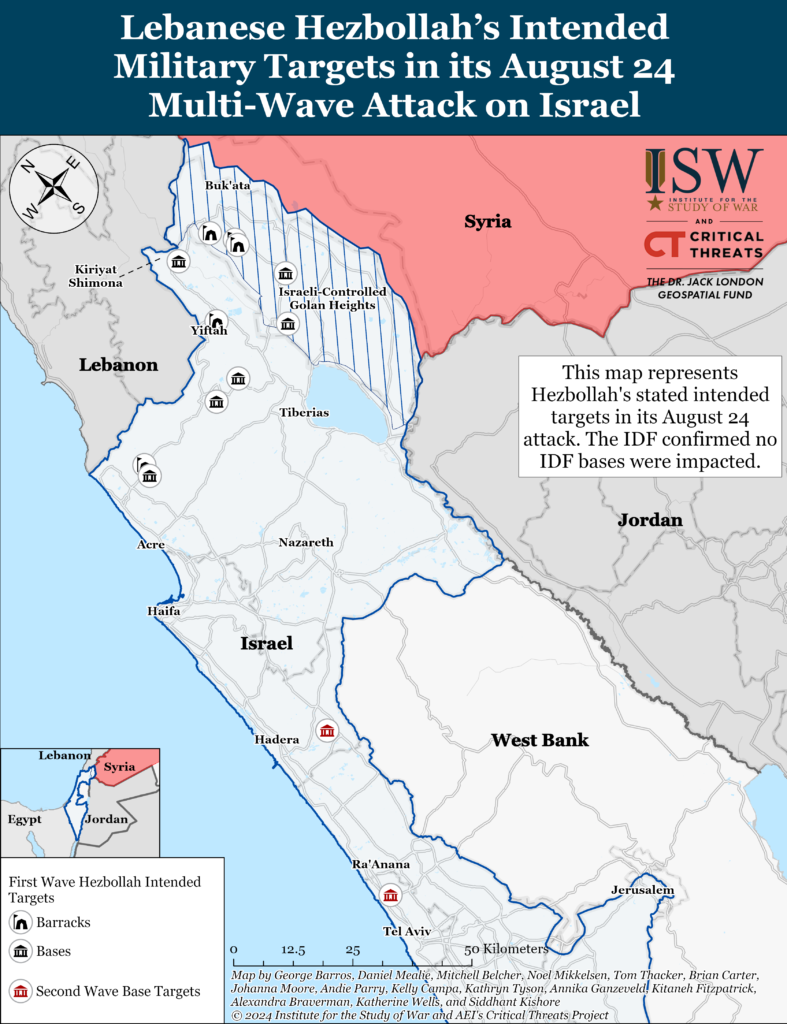
Hamas rejected Israel’s “new ceasefire conditions” following negotiations in Cairo on August 25.[26] A Hamas delegation led by head negotiator Khalil al Hayya arrived in Cairo on August 24 to “listen” to the results of negotiations between US, Egyptian, Israeli, and Qatari mediators.[27] Senior Hamas political official Izzat al Rishq said that the Hamas delegation met with Egyptian and Qatari mediators and left Cairo on the evening of August 25.[28] Al Rishq also said that the Hamas delegation demanded that Israel commit to the July 2024 ceasefire-hostage proposal that Hamas backs.[29] Senior Hamas official Osama Hamdan told the Hamas-run network al Aqsa TV that Hamas will not accept “retractions” or “new conditions” from the July 2024 proposal.[30] Hamdan said that Hamas has given the mediators its response to the latest proposal.[31] Hamas previously rejected the latest US-proposed ceasefire-hostage proposal following talks in Doha on August 18 and similarly accused Israel of setting ”new conditions and demands” that obstructed the negotiations.[32]
Key Takeaways:
- Lebanese Hezbollah conducted a drone and rocket attack on Israel in response to Israel killing a senior Hezbollah commander, Fuad Shukr. Hezbollah meant for its attack to be much larger than it was.
- Hezbollah and the rest of the Axis of Resistance have indicated that the Hezbollah attack is only the beginning of their retaliation. The Axis of Resistance will likely learn lessons from the Hezbollah attack in order to improve the efficacy of future attacks on Israel.
- Iranian Supreme Leader Ali Khamenei referenced the Axis of Resistance’s war against Israel during a prayer ceremony in Tehran.
- Hamas rejected Israel’s “new ceasefire conditions” following negotiations between US, Egyptian, Israeli, and Qatari officials in Cairo.
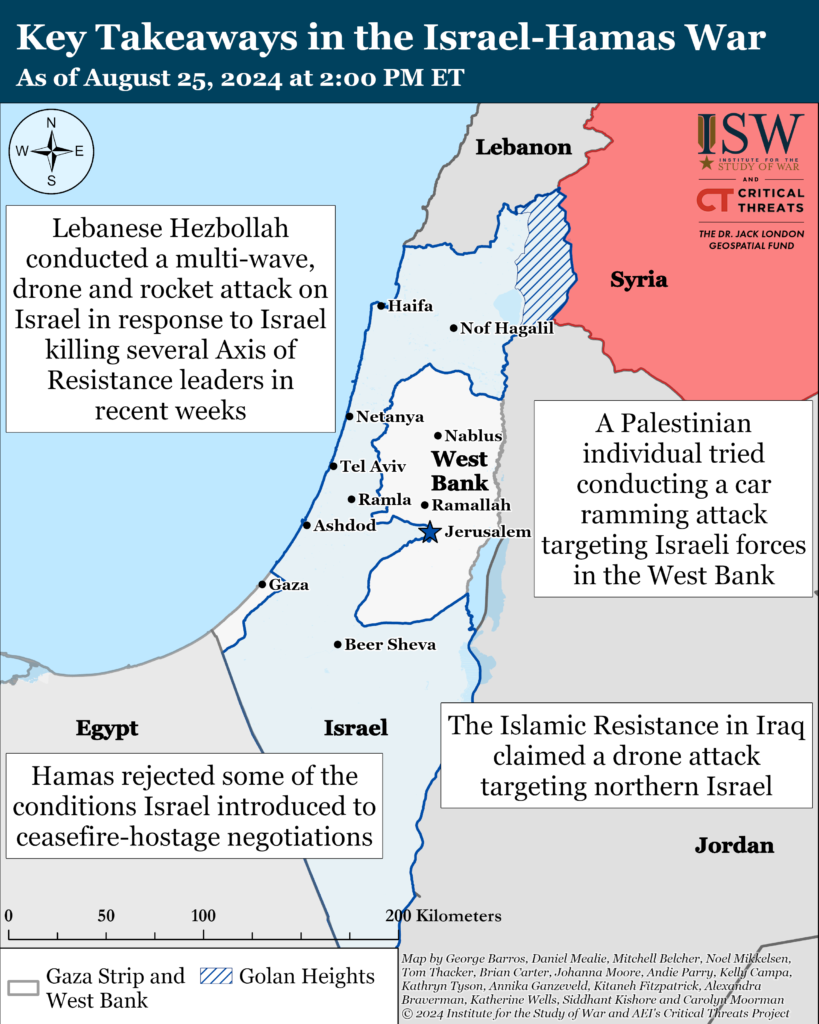
Gaza Strip
Axis of Resistance objectives:
Erode the will of the Israeli political establishment and public to sustain clearing operations in the Gaza Strip
Reestablish Hamas as the governing authority in the Gaza Strip
The IDF 252nd Division continued operations around the Netzarim Corridor on August 25. The IDF 16th Jerusalem (Reserve) and 10th Harel (Reserve) brigades have operated around the Netzarim Corridor to target Palestinian fighters and militia infrastructure for the past month.[33] The IDF stated on August 25 that the two brigades have killed over 200 Palestinian fighters and destroyed hundreds of militia sites and infrastructure in the area.[34] Israeli forces also located and destroyed a “strategic” militia tunnel that connected the northern and southern Gaza Strip.[35] A Palestinian journalist reported that Israeli forces advanced near Kuwait Circle in Zaytoun on August 25.[36]
The IDF stated that the two combat brigades have engaged in heavy fighting in the area in recent days.[37] Palestinian fighters targeted Israeli forces with rocket-propelled grenades (RPG) and killed an IDF reservist in the 8119th Battalion near the Netzarim Corridor on August 24.[38] Palestinian militias continued to engage Israeli forces in southern Gaza City on August 25. Hamas, Palestinian Islamic Jihad (PIJ), and the Democratic Front for the Liberation of Palestine (DFLP) detonated improved explosive devices (IED) targeting Israeli dismounted infantry and armor operating in Zaytoun.[39] Hamas fighters also targeted an Israeli soldier with sniper fire in Tal al Hawa.[40]
Two Palestinian militias fired rockets targeting Israeli forces east of Deir al Balah on August 25.[41]
The DFLP mortared Israeli forces in Brazil neighborhood, Rafah city, on August 25.[42]
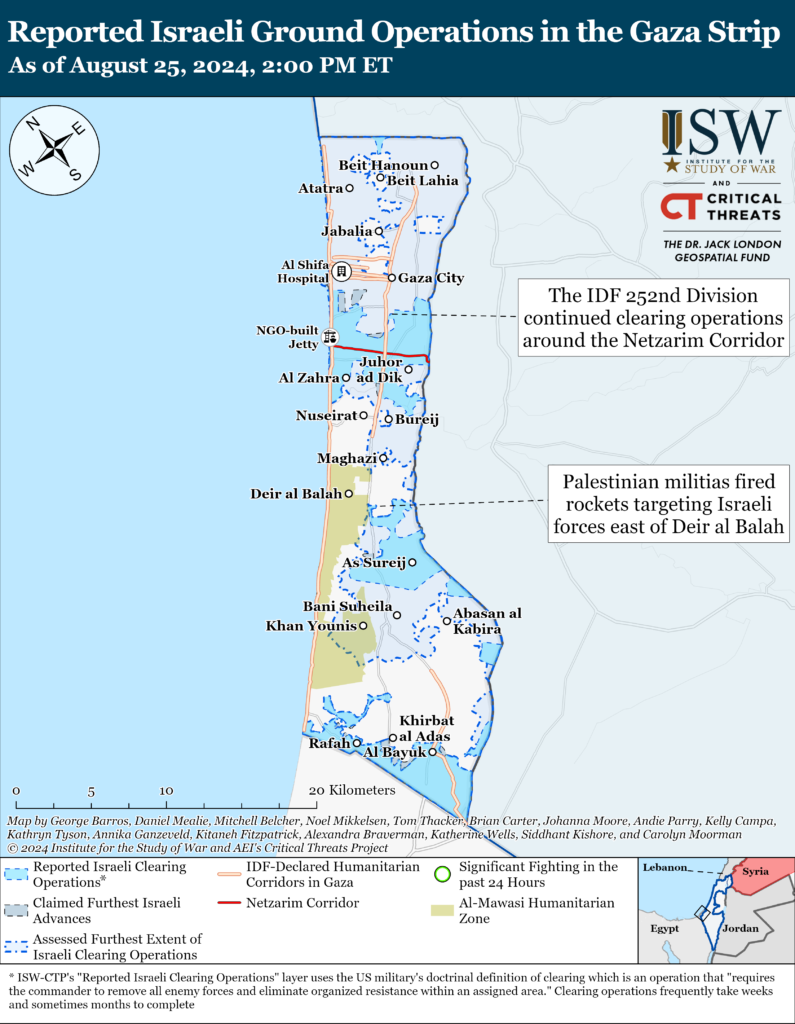
The IDF issued evacuation orders for a section of al Mawasi humanitarian zone in Deir al Balah on August 25.[43] The IDF said that it considers the area a “dangerous combat zone” and that it will “act forcefully” against Hamas and other militias in the area.[44] The IDF told Gazans to evacuate immediately further into the humanitarian zone to the west.[45]
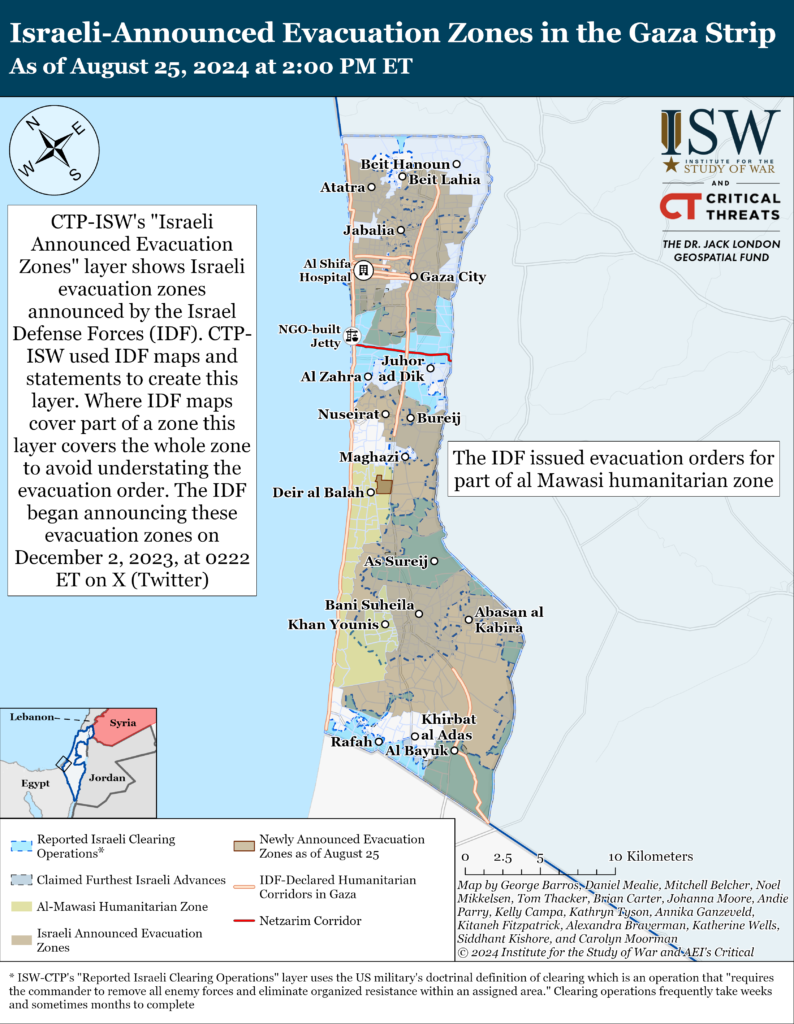
Three Palestinian militias mortared Israeli military sites in southern Israel on August 25.[46]
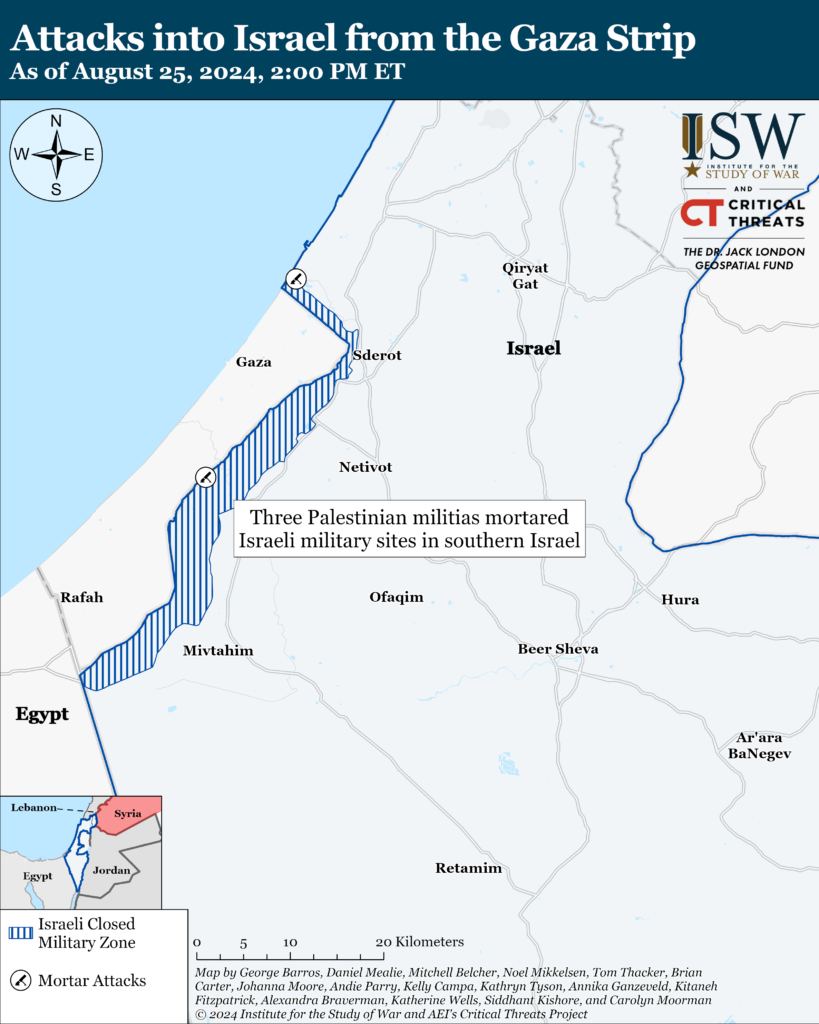
Recorded reports of attacks; CTP-ISW cannot independently verify impact.
West Bank
Axis of Resistance objectives:
Establish the West Bank as a viable front against Israel
Israeli forces have engaged Palestinian fighters in at least two locations in the West Bank since CTP-ISW’s last data cutoff on August 24.[47] The al Aqsa Martyrs’ Brigades fired small arms and detonated IEDs targeting Israeli forces in Balata refugee camp in Nablus.[48] Two Hamas fighters fired small arms targeting an IDF checkpoint in Jenin.[49] The IDF reported that it killed one Hamas fighter and is searching for the other fighter.[50]
A Palestinian individual attempted a car ramming attack targeting the IDF Ariel checkpoint in the West Bank on August 25.[51] Israeli media reported that a Palestinian man driving a car collided with Israeli vehicles and attempted to ram into the IDF checkpoint at the Ariel intersection.[52] The IDF reportedly killed the attacker and dispatched more troops to the area where the attack occurred. [53]
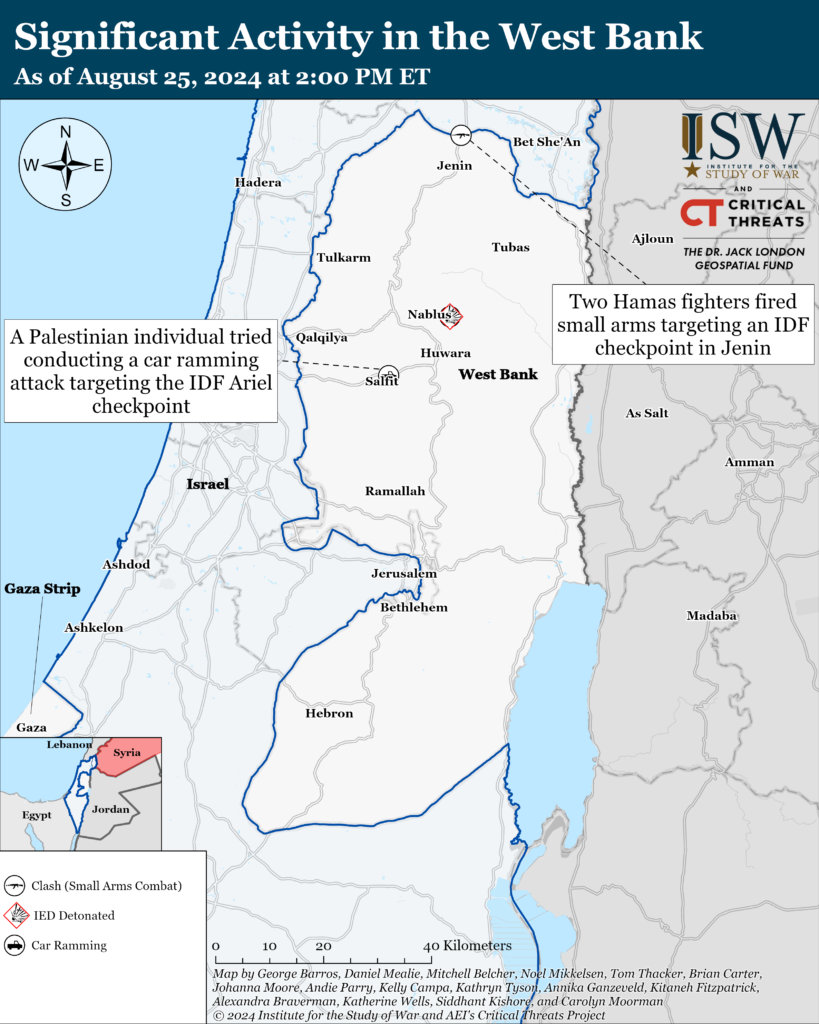
Southern Lebanon and Golan Heights
Axis of Resistance objectives:
Deter Israel from conducting a ground operation into Lebanon
Prepare for an expanded and protracted conflict with Israel in the near term
Expel the United States from Syria
Lebanese Hezbollah has conducted at least two attacks into northern Israel since CTP-ISW’s last data cutoff on August 24.[54] Hezbollah claimed that it fired rockets targeting an IDF base in Raheb and launched a one-way attack drone targeting Manara in northern Israel.[55] These attacks are separate from Hezbollah’s retaliation strikes targeting northern and central Israel in response to Israel killing senior Hezbollah official Fuad Shukr (see topline).
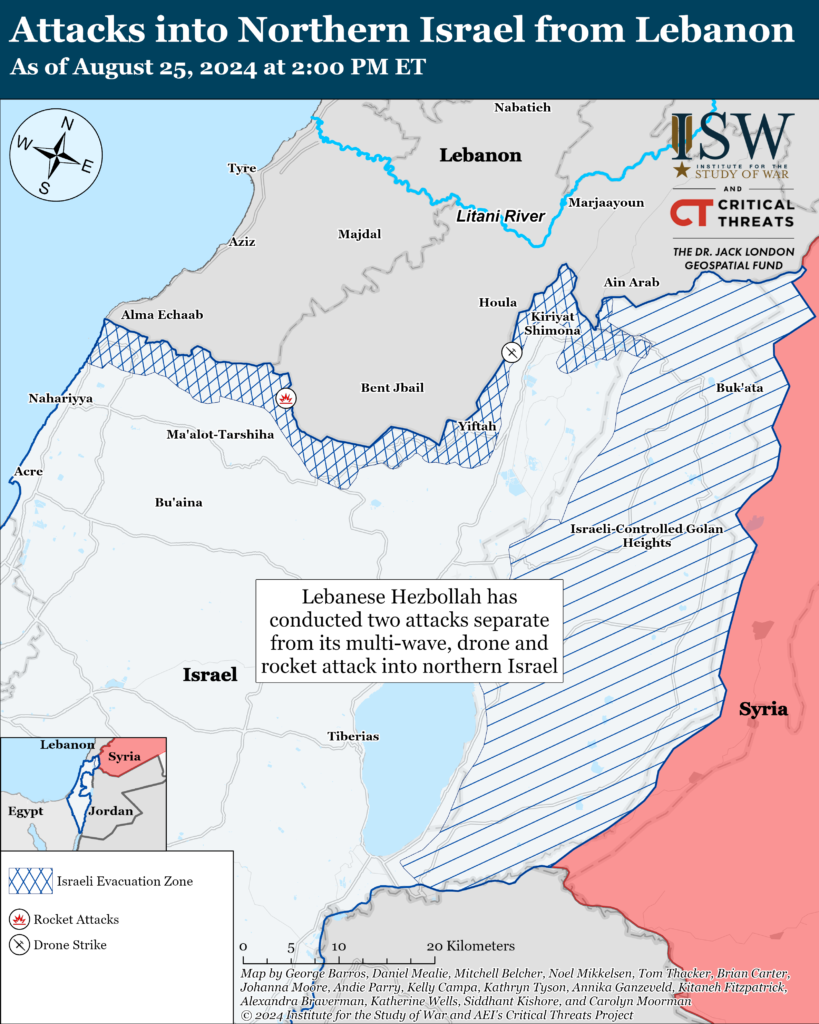
Iran and Axis of Resistance
The Islamic Resistance in Iraq—a coalition of Iranian-backed Iraqi militias—claimed a drone attack targeting an unspecified target in Haifa, Israel on August 25.[56]
 Eurasia Press & News
Eurasia Press & News
